June 12, 2020
Air Date: June 12, 2020
FULL SHOW
SEGMENTS
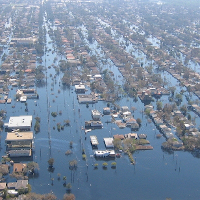
Race and Environmental Justice
View the page for this story
Environmental pollution and exposure to climate risks are closely linked with systemic racism. For example, Black communities are exposed to higher rates of pollution than non-Hispanic white communities, and tend to experience the worst of heat waves linked with climate disruption. Heather McTeer Toney, the National Field Director for Moms Clean Air Force, joins Host Steve Curwood to talk about these links and how the national environmental organizations have long sidelined Black organizers. (09:46)

Beyond the Headlines
/ Peter DykstraView the page for this story
In this week’s trip beyond the headlines, Environmental Health News Editor Peter Dykstra updates Host Steve Curwood on a new executive order that would allow fossil fuel companies building pipelines to bypass key environmental regulations, as part of “emergency” measures to boost the economy. Peter and Steve also discuss plans to seal off a huge toxic “blob” in Lake Ontario, and the tenth anniversary of the political fallout from the 2010 Deepwater Horizon Spill. (04:36)
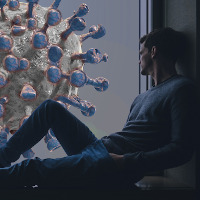
COVID-19 and Healthy Buildings
View the page for this story
The pandemic continues to spread, with over 7 million confirmed cases of COVID-19 worldwide on June 12. And research has shown that much of this spread has happened indoors. Host Steve Curwood speaks with Joe Allen, Director of the Healthy Buildings Program at Harvard University, about the steps we can take in our own homes, buildings, and even cars to reduce the risk of transmitting the virus. (06:07)
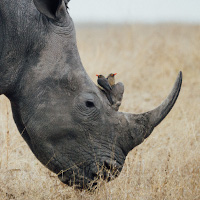
Red-Billed Oxpeckers and Black Rhinos
/ Don LymanView the page for this story
Oxpecker birds are known for riding on the backs of large mammals, feeding on the ticks and parasites that would otherwise plague their hoofed companions. Now, research indicates that oxpeckers may also help rhinos by acting as an early-warning system when they sense danger. Living on Earth's Don Lyman has the story. (02:33)
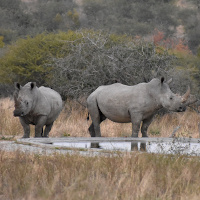
Coronavirus Reduces Rhino Poaching
View the page for this story
More than 80 percent of the world's African rhino population lives in South Africa, making the country the epicenter of the rhino poaching world. Though the number of rhinos killed has steadily decreased since 2014, the coronavirus pandemic has brought a major drop in poaching. Jo Shaw, Senior Manager and African Rhino Lead for the World Wildlife Fund, talks rhino poaching during the lockdown with Living on Earth's Bobby Bascomb. (07:22)
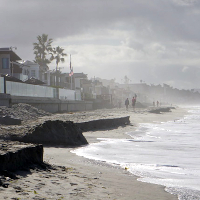
Climate Liability Cases Seek Big Damages from Big Oil
View the page for this story
Several California counties and cities are suing some 30 energy companies to seek compensation for the steep costs of building seawalls, relocating communities, and other sea level rise consequences of climate disruption. Now the litigation is one step closer to trial, as a federal appeals court has decided that the cases belong in California state court, where the plaintiffs have a better chance than in federal court. Vermont Law School Professor Pat Parenteau joins Host Steve Curwood to explain the stakes. (08:47)

Lyme Disease Risk is High in City Parks, Too
/ Kara HolsoppleView the page for this story
People in cities have been relying on parks for a dose of fresh air during the pandemic, but lurking in the leaf litter and elsewhere in the park might be the tiny ticks infected with the bacteria that causes Lyme disease. Kara Holsopple from The Allegheny Front has the story. (06:29)
Show Credits and Funders
Show Transcript
HOST: Steve Curwood
GUESTS: Joe Allen, Pat Parenteau, Jo Shaw, Heather McTeer Toney
REPORTERS: Peter Dykstra, Kara Holsopple, Don Lyman
[THEME]
CURWOOD: From PRX – this is Living On Earth.
[THEME]
CURWOOD: I’m Steve Curwood.
The demonstrations for Black Lives Matter have sparked a conversation about environmental equity for black communities.
TONEY: Over a million African Americans right now live within 1 mile of oil and gas operations. This is showing the prevalence of African American communities to environmental injustices that have a disparate health impact.
CURWOOD: Also, how the coronavirus pandemic is helping rhinos.
SHAW: We've seen a dramatic decline in the rates of rhino poaching since lockdown commenced. In Kruger National Park, which is home to the majority of rhinos in South Africa, only five rhinos were poached during April 2020 compared to 46 a year previously in April 2019.
CURWOOD: We’ll have those stories and more this week on Living on Earth – Stick Around!
[NEWSBREAK MUSIC: Boards Of Canada “Zoetrope” from “In A Beautiful Place Out In The Country” (Warp Records 2000)]
[THEME]
Race and Environmental Justice
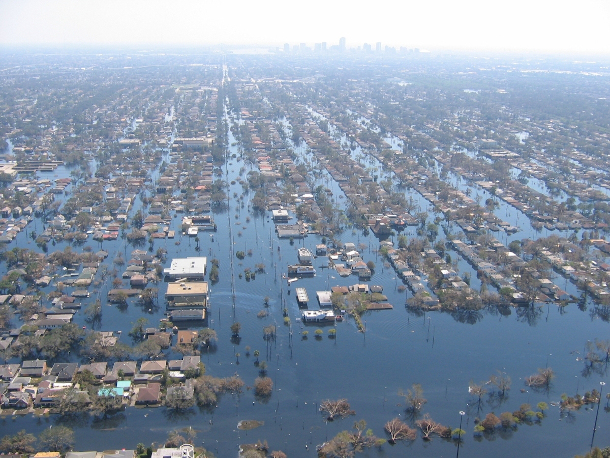
Hurricane Katrina led to $125 billion in damages and inundated New Orleans and surrounding areas for weeks. More than 300,000 people, mostly African Americans, were forced to evacuate from their homes. (Photo: Photographer: Lieut. Commander Mark Moran, NOAA Corps, Flickr, CC By 2.0)
CURWOOD: From PRX and the Jennifer and Ted Stanley Studios at the University of Massachusetts Boston, this is Living on Earth. I’m Steve Curwood.
The murder of George Floyd at the hands of Minneapolis police officers on May 25th touched off massive protest demonstrations around the world against police brutality and systemic racism. Both white and black people including journalists have been assaulted by police in the US during peaceful demonstrations. This, ironically, has opened the eyes of more white people to systemic failures that include institutional racism and taken Black Lives Matter into the mainstream. So more people are also seeing that the unequal impacts of pollution, climate disruption and Covid 19 on black and brown people stem from systemic risks that affect the health and safety of all. I’m joined now by Heather McTeer Toney, a former EPA regional administrator and now the field director for Moms Clean Air Force. Welcome to Living on Earth!
MCTEER: Thanks so much, Steve. It's great to be here. Thanks for having me today.
CURWOOD: Heather talk to me about, in your view how climate change disproportionately impacts communities of color.
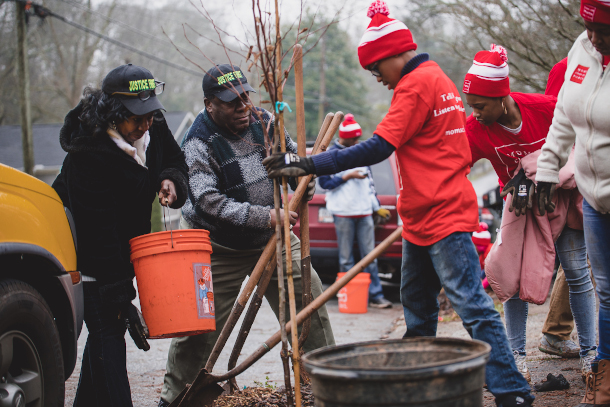
A team organized by Moms Clean Air Force planting trees and contributing to green spaces in their neighborhoods. (Photo: Courtesy of Moms Clean Air Force)
MCTEER: Climate change the way that it touches each and every human being is based upon where they live the demographics of their community what they do, and it doesn't touch all of us equally. And so right now today, you have one in nine African American children that are impacted by asthma and chronic disease is one of the easiest ways for us to identify impacts based upon things like air pollution, because we see it and can count it when we look at the number of people who are going into hospitals and who are missing days from school or missing days from work. And the NAACP did a report on environmental justice and they show that over a million African Americans right now live within one mile of oil and gas operations. When we add that together with things like the number of African American schools that are closely located in traffic zones, and the number of people who are working in these spaces, we can draw a clear line that shows that African American communities are more heavily impacted by environmental injustices. I was Regional Administrator for EPA in the Southeast, the Southeast covers eight states that space alone is over a quarter of the nation's population. About half of the nation's population of African Americans live in the Southeast. It also though, is very susceptible to storms and to floods and to sea level rise and so the number of African Americans and communities of color that live in these spaces, just by virtue of where they are, are impacted heavier. I think many of us can recall back to Hurricane Katrina and it was at the time the most devastating thing we had ever seen hit the United States. And because of technology, we were able to see the real life devastation, live on our television screens and on our Facebook messages and those images stuck with us. Let's now look at 2020 when we've not only seen a hurricane Katrina, but a hurricane Maria, we've seen a number of different hurricanes that have hit Florida that have hit Texas, Hurricane Harvey, and those impacts to communities of color are coming faster and stronger than ever before. So climate change is no longer something that is future. It is now it is existing, and we have to, I think really talk about how it encompasses absolutely every aspect of life, particularly for black and brown communities.
CURWOOD: So over the past 50 years, we've seen more and more heatwaves, average heatwave season across some 50 major cities in the US is now 47 pushing 50 days longer than it was in the 60s. And a lot of the people who are impacted by heat lays are those who live in urban communities, especially those in concrete brick buildings like public housing. To what extent does the heatwave phenomenon disproportionately affect people of color?
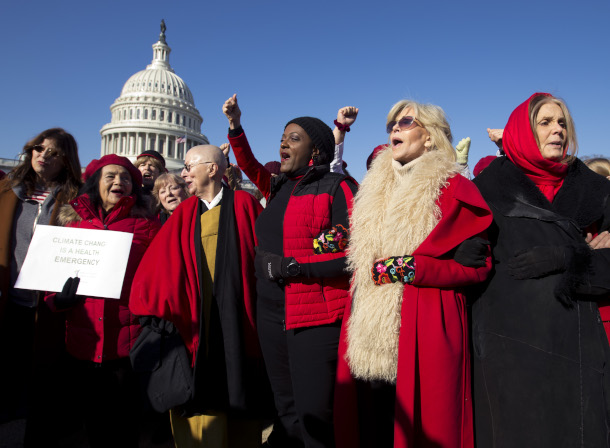
Heather McTeer Toney alongside other environmental activists like Jane Fonda during a Fire Drill Friday Climate Strike in Washington D.C. (Photo: Courtesy of Jose Luis Magana for Moms Clean Air Force)
MCTEER: I think you just said it. You outlined housing units places that historically have been home for people of color in urban communities. In the South, you know where I am in Mississippi, learning how to live in the heat is a part of what we have done for years. You know, when it gets to be the summertime you find a cool space to be in whether it's inside and air conditioning, if you can afford it or it's outside with a cool breeze and a tree. But the difference is there is so much greenery and land that it creates wide open spaces and the flow of air is different. So me standing under a tree in a Mississippi summer with it being 89 degrees is a lot different than someone living in a housing project in Chicago surrounded by impervious surface like concrete where that heat is trapped. And as a result creates a space that turns 89 degrees into 99 degrees.
CURWOOD: How fair is it to say that the image of climate activism is mostly white, and other communities aren't so close to this conversation? A couple of questions here. To what extent is this related to systemic racism and and what should black communities care and do about the discussion around climate disruption?

Picture of a protest in Minneapolis after the murder of George Floyd by a Minneapolis police officer. (Photo: Courtesy of Kori Suzuki)
MCTEER: The first thing we have to address is the definition of environmentalists. If you do a Google search, of what does an environmentalist look like, you come up with pictures of trees and white people hugging trees and Birkenstocks and vegans. And that unfortunately, is the image and the stereotypes that our country has placed on what an environmentalist is and what it looks like. And it doesn't reflect the image of me. It doesn't reflect the image of my children. It doesn't reflect images of community, it’s very singular. And that has been the fight that we've had to address mainstream environmental organizations having to grapple with the fact that there's been an ownership to environmentalism that has not been inclusive of all communities, despite the fact that communities of color have been engaged in environmentalism much longer than the mainstream environmental community really wants to address. So even you know, starting with our indigenous communities in this country, who are the original natural and environmentalist, but just recognizing that this connection to nature and this connection to protecting our planet looks different in different spaces. I've seen constantly white organizations try to go into black communities and teach them how to grow food. And you know, I have to push back and say, wait a minute, you know, our folks were brought from different countries. I mean, enslaved Africans came to this country. And we brought with us and had to teach white people how to grow food. So, you know, you're trying to teach me something that my folks taught you years ago, and having that very real conversation, to pull back the curtain of understanding the connection of certain cultures to the environment, and then from that space developing solutions, I think is where we are now.
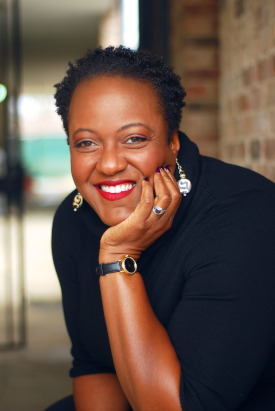
Heather Mcteer Toney is former Mayor of Greenville, MS and Southeast EPA Regional Administrator during the Obama Administration. She currently leads the field program for Moms Clean Air Force. (Photo: Courtesy of Moms Clean Air Force)
CURWOOD: Heather, I think a big part about the current racial justice movement is recognizing that the colonialist mentality is still alive and well amongst a large part of the population and having a conversation about how that disproportionately affects communities of color. But, but how do you think we should move forward to change the dire environmental conditions which black communities are exposed to right now?
MCTEER: So yes, that colonial mentality is existing, but it's also being revealed and changed and shifted in every single conversation that we have including ones like the one we're having today. I think people are listening now in a different way and recognizing again, that there's been a shift and there will continue to be a shift in the power structure of our country, as well as the impacts that people are making locally. You know, folks showing up and saying that we want to ensure we have a fair and equitable future is certainly not going unnoticed, but we have to keep showing up. Protesting about the racial injustice we're experiencing and turning that into political power puts people in office that want to see social justice change in both the environmental community, in the policing community, in the educational community, in the housing community, and understanding that all of these are linked together. It is more black and brown people sitting in office, whether it be an elected position, or in an appointed position. But being this person in the space to make and voice these changes as a collective unit. It's all about seeing people and meeting people where they are, and then turning that into activism and engagement for the benefit of all of us.
CURWOOD: Heather McTeer Tony is the former Mayor of Greenville, Mississippi and the Regional Administrator for the Environmental Protection Agency, and now the national field program leader for moms Clean Air Force. Heather, thanks so much for taking the time with us today.
MCTEER: Thanks so much for having me, Steve.
Related links:
- LA Times | “Why Communities Demanding Fair Policing Also Demand Environmental Justice”
- The Guardian | “‘They Choose Us Because We Are Rural Poor’: When Environmentalism and Climate Change Collide”
- The New York Times | “Read Up on the Links Between Racism and the Environment”
- Learn more about Moms Clean Air Force
[MUSIC: James Cotton, “Blues In My Sleep” on Deep In The Blues, Universal Music Jazz France]
Beyond the Headlines
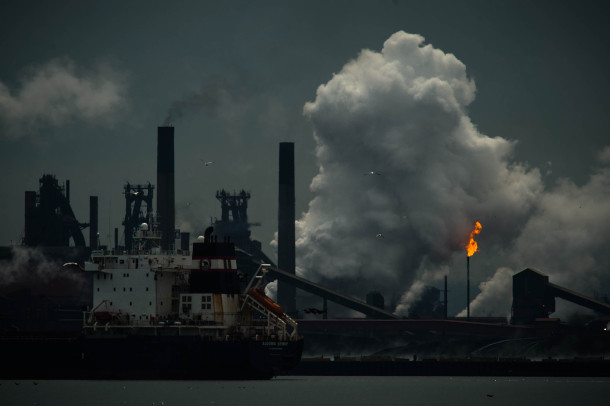
Hamilton Harbor’s toxic blob is 6 blocks long, and the result of over 150 years of pollution. (Photo: Mark Ziubinski, Wikimedia Commons, CC BY 2.0)
CURWOOD: It's time now for us to take a look beyond the headlines with Peter Dykstra. Peter's an editor with environmental health news, that's ehn.org and dailyclimate.org. With us now from Atlanta, Georgia, Peter, Hey, what's going on?
DYKSTRA: Hi, Steve. You know, if you're the Trump administration, what better time to sneak in some of the biggest rollbacks of environmental laws and regulations, then when the country and the world are consumed with two massive stories, the COVID pandemic and of course the police brutality behind George Floyd's murder and so many other cases.
CURWOOD: Not to mention the economic meltdown or whatever we call it. I think they labeled it a recession the other day.
DYKSTRA: Yeah, let's hope things only come in threes. But what has happened much more quietly, is that there are potential violations of the Clean Air Act, the Clean Water Act, the National Environmental Policy Act, Endangered Species Act, other laws and regulations that could be ignored according to a new Trump executive order in what he calls emergency measures involving the oil and gas industry, and the coal industry as well as other projects, particularly pipeline construction.
CURWOOD: Hmm. I understand there's a climate emergency, Peter, but I don't figure how this order helps that.
DYKSTRA: No, it's not going to help it at all. This is something that will certainly be contested in court by environmentalists and other affected parties. There's an element of environmental racism in the background here, because as with many pollution issues, minority communities could also be disproportionately affected by Trump's executive order.
CURWOOD: So the President has been getting out and about with his orders, he just was recently in Maine. What did he bring to help his campaign there?
DYKSTRA: Well, he's reeled in another big one in terms of environmental rollbacks, a marine monument, a Protected Area off the coast of Maine, instead of being off limits for commercial fishing will now be inviting commercial fishermen in if litigation doesn't stop the newest roll back from Trump.
CURWOOD: Hey, what else do you have for us today?
DYKSTRA: A story about thick, black toxic, 150 year old blob in Lake Ontario in Hamilton Harbor, Hamilton an industrial city on the Canadian side of Lake Ontario. And in that Harbor, there's a blob that stretches about six blocks. It started in the 1870s with coal tar waste from a coal facility. Other polluting industries have added to it since, they've known about it for 30 years, but they have no idea how to deal with it. You can't just start to dig up a blob without releasing its pollution elsewhere and maybe making things worse for things like the drinking water supply for Canada's biggest city Toronto. So they've decided to build a box around the Hamilton blob for a potential multimillion dollar solution.

Gas from the damaged Deepwater Horizon oil well is burned by the drillship Discoverer Enterprise, May 16, 2010 in a process known as flaring. (Photo: Petty Officer 3rd Class Patrick Kelley, DVIDSHUB, Flickr, CC by 2.0)
CURWOOD: The blob box huh?
DYKSTRA: They're not quite sure if it's gonna work, but over 30 years of agonizing of how to deal with this major pollution problem, they're thinking it's worth a try.
CURWOOD: Okay, and tell me what you see in terms of history today, Peter?

Congressman Joe Barton of Texas demanded that Former President Barack Obama apologize to British Petroleum for the more than 20 billion dollars in fines that his administration levied against them to pay for cleanup costs from the Deepwater Horizon spill. Obama never caved to these demands. (Photo: Gage Skidmore, Wikimedia Commons, CC by S.A. 2.0)
DYKSTRA: Well, it's a 10th anniversary for June 13 2010, nearly two months after the Deepwater Horizon spill, it was still flowing and Representative Joe Barton demanded an apology, not from British Petroleum but to British Petroleum, from President Obama, for conducting what Barton said, was a shakedown in cleanup costs. BP had agreed to pay at that point 20 billion to the administration for cleanup costs.
CURWOOD: But of course, a little while later, the numbers started to come out.
DYKSTRA: The numbers started to come out, the spill was quite a bit higher. It took a lot more than two months to even cap the spill. Its impacts are still uncertain. And the congressman known as Smokey Joe Barton left office in the last election cycle. President Obama never backed down from trying to get BP to pay up.
CURWOOD: Thank you. Peter. Peter Dykstra's an editor with environmental health news that's ehn.org and dailyclimate.org. We will talk to you again real soon.
DYKSTRA: All right, Steve, thanks a lot. Talk to you soon.
CURWOOD: And there's more on these stories at the Living on Earth website. That's L-O-E.org
Related links:
- The Hill | “Trump Signs Order Removing Environmental Review for Major Projects”
- The Narwhal | “Lake Ontario ‘Aquatic Landfill’ to Contain 150-Year-Old Toxic Blob from Industrial Pollution”
[MUSIC: Coulter & Verdery, “Frieze Britches” on Song For Our Ancestors, traditional/arr.Coulter & Verdery, Solid Air Records]
CURWOOD: Coming up – how to stay healthier in buildings in the time of coronavirus.
That’s just ahead on Living on Earth.
ANNOUNCER: Support for Living on Earth comes from Sailors for the Sea and Oceana. Helping boaters race clean, sail green and protect the seas they love. More information at sailors for the sea dot org.
[CUTAWAY MUSIC: The Lee Boys, “Tribute to Calvin Cooke” on Say Yes!, by Alvin Lee, Arhoolie]
COVID-19 and Healthy Buildings
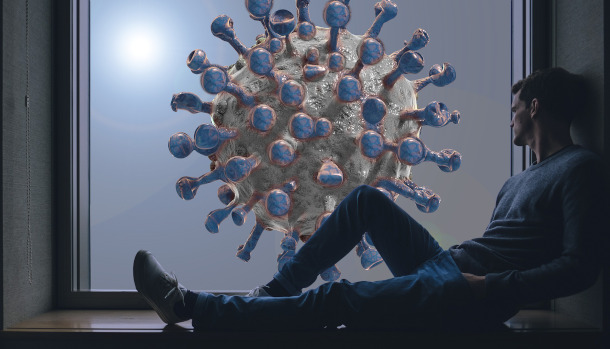
Opening a window can help reduce the transmission of coronavirus indoors. (Photo: Gerd Altmann, Pixabay)
CURWOOD: It’s Living on Earth, I’m Steve Curwood.
Love your neighbor, but stay away and wear a mask, especially indoors. That’s the ethos of the COVID-19 pandemic that has already taken more than one hundred thousand lives in the US and sickened four million people around the world. Direct sunlight, fresh air and heat can quickly disperse contagious virus particles in the air outdoors but inside those particles can linger in the air for three or more hours. Fortunately, there are ways to be safer indoors, according to Joe Allen who teaches at the T H Chan School of Public Health and directs the Healthy Buildings Program at Harvard University. I asked Professor Allen to explain how buildings can be set up to reduce the spread of the virus.
ALLEN: Well, you know, so buildings play a central role and we've long known historically that buildings that perform poorly can aid in the transmission of disease. We know this from thinking about measles in schools, and a classic example: one school girl goes into a building. Dozens get infected despite being vaccinated because of a poorly performing HVAC or mechanical air conditioning system. We see examples from the first SARS outbreak of one person going into a hotel, 16 other people become infected seeding a global outbreak, and even right from this SARS-CoV-2, this COVID-19 disease, we see examples from the cruise ships, the Biogen conference, the Kirkland senior homes and on and on all showing that the building plays a key role in transmitting that disease. The good thing is that we also know this means that the buildings are performing well that they can act as a first line of defense.
CURWOOD: Tell us everybody is really excited to hear from you just how healthy buildings can be brought into this fight against the coronavirus which, as we speak today, there's no vaccination, there's really kind of a bit of treatment for it?
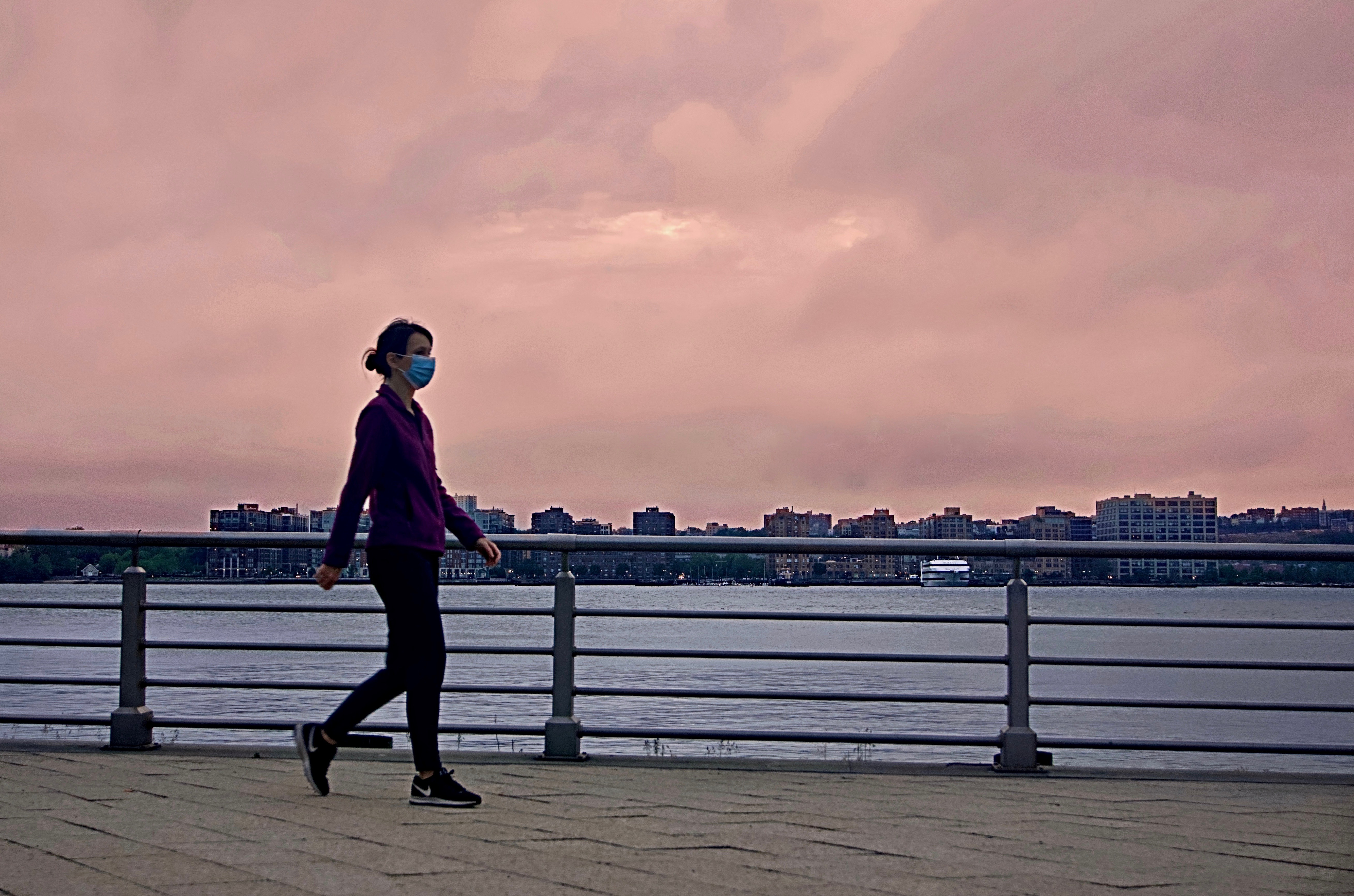
A walker on the Chelsea Piers in Manhattan. Joe Allen advocates for public parks to remain open as long as social distancing is practiced. (Photo: Andreas Komodromos, Flickr CC BY-NC 2.0)
ALLEN: Yeah. So you know, when we think about buildings, we first have to think of how we're exposed to this virus. So quick little primer right three modes of transmission, large droplet transmission foamite, which is inanimate surfaces that act as a source of transference and airborne transmission. And healthy buildings can act on all three of these. So let's start with that airborne one, and how you would do that. So if you bring in a little more fresh outdoor air, you dilute airborne contaminants indoors, the real basics here. Second, if you're recirculating that air and many buildings do recirculate air, you want to enhance the level of filtration so that if there's any virus in the air, it's captured or impacted out on a high efficiency filter. Then in terms of other strategies, you want to enhance cleaning and disinfection, which addresses foamite transmission. And then of course, we have to do all these things that you and I and everybody else should be doing, maintaining physical distancing, hand washing, covering our coughs, staying home and sick. Those are not necessarily building controls, but we can't just say the building has the sole responsibility. We all have a role to play here. And so it's getting back to the basics of buildings and public health one on one right now, in terms of how we combat this disease and the indoor environment we know is key to the spread of this virus, but it can be leveraged in the fight against it.
CURWOOD: So Joe, one of the things I think I just heard you say is that if you open the windows in a building, that could help reduce the spread of this virus, how does into a transmission of the virus compared to being say completely outside?
ALLEN: Well, look, right. If you can be outside, you have unlimited dilution, so that's a good thing, right? I Marc Lipsitch and I at the Harvard School of Public Health with Ned Friedman, the director of the Arnold Arboretum at Harvard, have written a piece urging governments to keep parks open. They can be managed safely, the exposure risk is lower, if people behave as they should and take the proper appropriate precautions. But you're exactly right. You know, it's as simple as getting back to the basics, opening your windows a little bit at home, in your car if you're with other people, we did some modeling with Professor Rich Corsi and Jack Spengler that showed if you just crack the window three inches, you can significantly reduce the amount of virus in the air if someone is sick and shedding virus through coughing, sneezing, or just breathing. So it's the real basics here, bring in some more outdoor air.
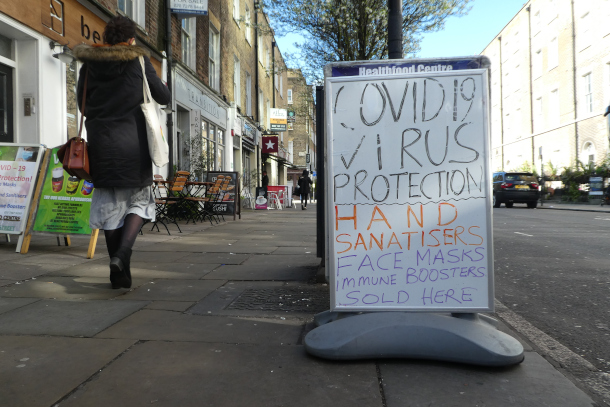
As Joe Allen describes, COVID-19 spreads through large droplets, contaminated surfaces, and aerosol transmission. (Photo: Duncan C, Flickr CC By-NC 2.0)
CURWOOD: And remind us, Joe, of why the amount of virus matters in this situation. Why obvious if you roll the window down, there's still going to be some virus. Why does that make a difference?
ALLEN: Yeah, I like that you asked that because this is you know, my official professor title is a professor of exposure assessment science. And this is the basics of exposure science. You have to think about exposure at three variables really one is the intensity of the exposure. So how much are you breathing and exposed to, second is frequency and the third is duration. So let's make this really understandable. If you and I were together and I was infectious and I cough and we're close, well, that intensity is going to be high, just because we're close, it will be less intense if you're on the other side of the room. The frequency matters too, because if I cough once, that's a certain amount of viral shedding. If I cough every 10 seconds, that's a lot more, so the frequency is intense. And last is that duration factor. If we had a one minute conversation where I coughed, that's very different than if you and I sat together for a couple hours, and I'm frequently coughing and you're close by. So it's a combination of intensity, frequency and exposure. And if you can reduce all of those, you reduce your exposure and therefore ultimately reduce your risk.
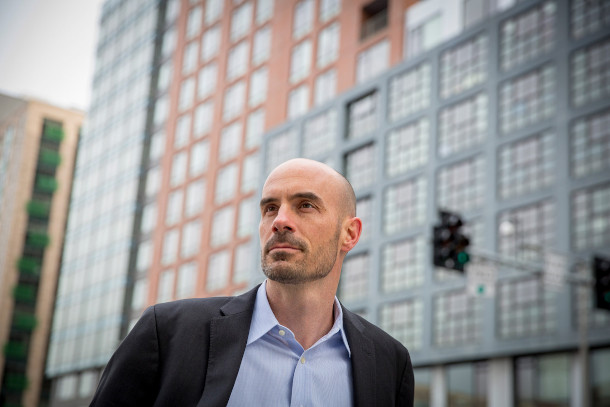
Joe Allen directs Harvard’s Healthy Buildings program. (Photo: Courtesy of Joe Allen)
CURWOOD: So there's a lot of chatter, some people are saying, if people want to get together, it's better to meet outside. For example, if I have my daughter and her husband and their new baby, come and visit me be outside at the picnic table, there's a bit of a breeze. I'm going to be better off there?
ALLEN: Yeah, definitely. You know, we started out by saying social distancing, but I don't like the term. Really, it's physical distancing, right? We still want to connect we still need to connect with people and we can do this outside my family did this last weekend where everyone met in the backyard, each family had their own little corner on the deck. Maintain physical distancing, you know couldn't do the hugs are handshakes but that's okay. You know, it's just great to see people in person and you can do it outside. You know the family stayed in a pod or a cluster and we just maintain a minimum of six foot distance between people.
CURWOOD: Joe Allen is an Assistant professor at the T H Chan School of Public Health and directs the Healthy Buildings Program at Harvard University.
Related links:
- About Joe Allen
- The Washington Post | “Keep Parks Open. The Benefits of Fresh Air Outweigh the Risks of Infection”
- Joe Allen’s latest book, Healthy Buildings: How Indoor Spaces Drive Performance and Productivity
[MUSIC: The Lee Boys, “Call Him By His Name” on Say Yes!, by Glenn Lee, arr. by Alvin Lee, Arhoolie]
CURWOOD: Just ahead, when it comes to rhino poaching in South Africa the pandemic is playing a surprising role. But first this note on emerging science from Don Lyman.
[SCIENCE NOTE THEME]
Red-Billed Oxpeckers and Black Rhinos

Two oxpeckers perch atop the head of a Black Rhino. (Photo: Wendy, Flickr, CC BY-NC-ND 2.0)
LYMAN: Red-billed oxpeckers are a species of bird that lives in the African bush. These eight-inch-long brown birds with distinctive red bills and yellow-ringed red eyes can often be seen riding on the backs of large mammals, including giraffes, Cape buffalo, and endangered rhinos, where they feed on ticks and other parasites on the animals’ hides.
But new research reveals that the oxpeckers’ symbiotic services extend beyond parasite removal. Rhinos have very poor vision but oxpeckers can see exceptionally well and issue a shrill alarm call which can warn the rhinos of potential danger.
Researchers in the study approached 11 black rhinos by foot on the open plain on 86 occasions. They found that rhinos with a red-billed oxpecker on their backs were much better at detecting the researchers’ presence than those without an oxpecker.
Rhinos without oxpeckers on their backs were able to detect the scientists approaching only 23 percent of the time, but rhinos with oxpeckers detected the scientists 100 percent of the time. The researchers also reported that rhinos listening to an oxpecker’s alarm call picked up on the approaching scientists from 61 meters away, more than twice as far as when there were no oxpeckers with the rhinos.
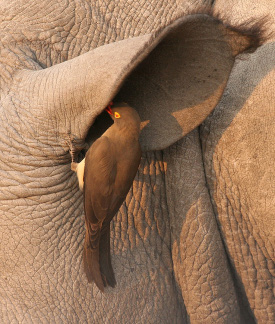
A red-billed oxpecker near a rhino’s ear. (Photo: Brian Scott, Flickr, CC BY-NC-ND 2.0)
All the rhinos they observed responded to the oxpeckers’ alarm calls by becoming more vigilant — they stood up if they had been resting — and turned to face downwind. Then the rhinos either ran away or walked downwind to investigate the potential danger.
Black rhinos where at one time the most numerous species of rhino in the world, but poaching for traditional Chinese medicine has resulted in black rhinos becoming critically endangered. Only an estimated 5,500 black rhinos remain in the wild.
Red-billed oxpeckers numbers have declined as well because of pesticides used to kill parasites on domestic cattle, which the oxpeckers also feed off of.
The researchers said that oxpeckers may help rhinos evade poachers, but one wildlife biologist cautioned that a lot of poaching takes place at night when the oxpeckers would be sleeping and not able to alert the rhinos to approaching danger.
That’s this week’s note on emerging science. I’m Don Lyman.
Related links:
- Read the study in Current Biology: Oxpeckers Help Rhinos Evade Humans
- National Geographic | “Bird Alarm Calls Help Rhinos Avoid People—And Possibly Poachers”
[SCIENCE NOTE THEME]
Coronavirus Reduces Rhino Poaching
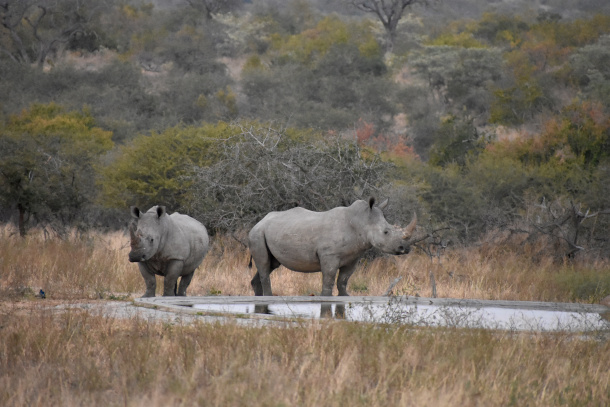
Two white rhinos in Kruger National Park. (Photo: Jen, Flickr, CC BY 2.0)
CURWOOD: More than 80 percent of the African rhinos remaining in the world are in South Africa, making it the hotspot for rhino poaching. The numbers of rhinos killed for their horns has been slowly declining over recent years but the COVID-19 pandemic, and a strict lockdown by the South African government, has quelled rhino poaching even more. Jo Shaw, Senior Manager and African Rhino Lead for the World Wildlife Fund spoke with Living on Earth’s Bobby Bascomb.
BASCOMB: Jo, what were the statistics and the numbers of rhinos poached in South Africa before and after the Coronavirus began?
SHAW: So, Bobby, as you know, rhino poaching has been a major problem in South Africa for the last decade, probably peaking around 2014 when we were losing around three rhinos a day. There has been quite a gradual decline since then, to a total of 594 animals killed in 2019. But since the COVID pandemic and the major lockdown that's been put in place in South Africa, we've seen a dramatic decline in the rates of Rhino poaching since lockdown commenced. The Minister of the Environment, Forestry and Fisheries stated that April 2020, in Kruger National Park, which is home to the majority of rhinos in South Africa, only five rhinos were poached during April 2020 compared to 46, a year previously in April 2019.
BASCOMB: And why do you think that is?
SHAW: It's something we're digging into to try and understand better. I mean, I think there are probably, as always, with this complex problem, a number of different explanations at different layers. So, all of the parks have been closed. Gates are shut, lodges are shut. There's nobody coming into the parks, but the rangers themselves are essential services, so they're able to continue to do their jobs. And South Africa itself has had a very restrictive lockdown process. So, people have been confined to their homes, only more recently able to get out once a day to exercise. On top of that movement between provinces has been restricted, and even international flights have been closed. So there's very little opportunity for people or rhino horn products to be trafficked.
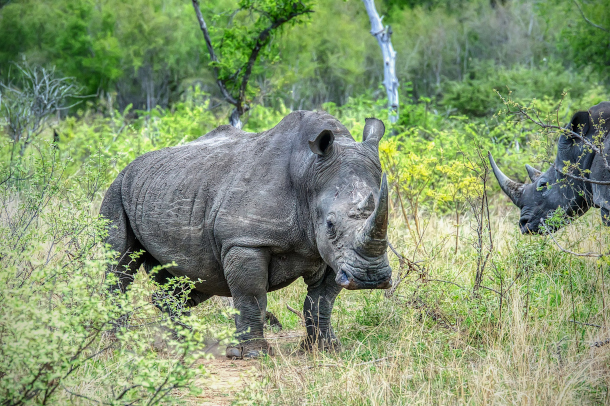
It’s speculated that the decline in rhino poaching numbers are impacted by the shutdown of international travel, making it harder to traffic the rhino horn to buyers. (Photo: Brook Ward, Flickr, CC BY-NC 2.0)
BASCOMB: So do you attribute then a lot of the drop in rhino poaching to a lack of demand? I mean, if they can't get the product out of the country to markets in Asia, I mean, what point is there? Is that sort of what you're thinking?
SHAW: Yes, it does seem as though there's been some breakage in the chain at some point. The Minister of the Environment released a statement in which she announced this very dramatic decline, and even suggested that perhaps the fact that in some of the larger parks like Kruger National Park, people had been using tourist entry gates to access the parks and to be able to go in and drop poachers off to kill rhinos. And perhaps the closure of these gates and the dramatic decrease in access into the parks had also just prevented people from being able to get into the park to poach rhinos.
BASCOMB: But of course poachers, by definition are already breaking the law. So I would think, you know, that they wouldn't worry so much about breaking the lockdown laws to continue the slaughter.
SHAW: Yes, there does seem to be this logistical blockage that somewhere down the line has made the system much harder to operate. The challenge now is to try and understand what is that weak link in the chain that's made such a big difference? And is there a way we can come up with to try and keep these numbers so low, even as lockdown restrictions are lifted. I think it's worth flagging that there is, of course a negative aspects to this closure of Parks and Tourism activities. In South Africa, tourism revenue is responsible for most of the operating budget of our parks in terms of protection, animal monitoring, animal management. And so without the income coming from tourists paying gate fees or paying for accommodation or game drives, our parks are seeing a really major decline, a huge loss of revenue that would normally be used to pay for the operating costs going forward. So I think this is something to be very concerned about in parallel.
BASCOMB: So, the trick then is to find a way to balance that. I mean, it's great for the poaching numbers. But obviously you need the revenue still, to keep the parks open in the future.
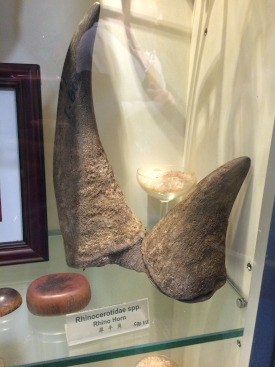
Rhino horn, seized by the Hong Kong government, on display in Hong Kong’s Agriculture, Fisheries and Conservation Department Visitor Center. (Photo: US Government Accountability Office, Public Domain)
SHAW: Yes, absolutely. Obviously, it's not the right solution for anybody for lots of reasons to maintain this very restrictive lockdown for a long period. I think what's going to be the challenge for all of us is to try and identify what are these narrow links in the chain where we've been able to stop the movement of rhino horn, and see if there's a way that we can replicate that without continuing to enforce a major lockdown.
BASCOMB: You know, it's easy to imagine the relationship between the pandemic and poaching going a totally different direction, you know, with no tourists around to deter the poachers. They could become more emboldened. And, of course, people can get really desperate when they suddenly can't go to work and support their families. How surprised were you, if at all, by the way this turned out?
SHAW: Yeah, I mean, this is definitely an unintended consequence of lockdown, obviously that we're, we're grateful for and as I say, trying to work on ways to continue post-lockdown. I think one of the other interesting pieces of information in the minister's recent release is the fact that bushmeat poaching, so snaring for meat within the parks also hasn't increased in the way that one might expect as people's livelihoods become less secure and jobs are lost. And in parallel with this challenge I've described going forward about the loss of operating budgets for parks. We need to be thinking about the people who live around them and the possible impacts of the loss of jobs due to the closure of nature based tourism businesses, and try and look for ways not just to diversify funding sources and funding income for parks, but diversify opportunities and make sure food security plans are in place for people who live in these areas?
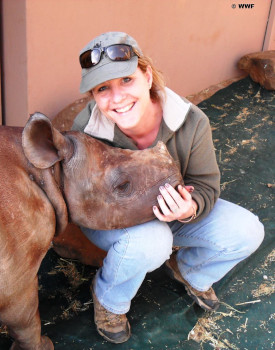
Jo Shaw is the African Rhino Lead for the World Wildlife Fund. (Photo: Courtesy of World Wildlife Fund)
BASCOMB: Well, that's the thing. It's not like, you know, the pandemic, let's say it's over tomorrow and things go back to normal immediately the next day. I mean, this is going to persist for a long, long time, the knockoff effects, the economic effects of the pandemic.
SHAW: Yes, I think the broader economic effects will be challenging for rhinos, and for conservation more broadly, for really quite a long time to come. It could take months, if not years for tourism to reach the levels that it was operating at previously. And without that money, we need to find other ways to fund our protected areas in Africa, but, but also in Asia, in the States, around the world. I think it's a big challenge for everybody to be considering.
CURWOOD: That’s Jo Shaw, Senior Manager and African Rhino Lead for the World Wildlife Fund speaking with Living on Earth’s Bobby Bascomb.
Related links:
- South African Department of Environment, Forestry, and Fisheries | “Rhino Poaching Drops Significantly During COVID-19 Lockdown”
- A statement from South Africa’s Department of Environment, Forestry, and Fisheries on the decline of rhino poaching in 2019
[MUSIC: Paul Simon, “Crazy Love Vol. II” on Graceland, by Paul Simon, Warner Bros. Records]
CURWOOD: Please join us for the next live Living on Earth Good Reads on Earth event. We will be speaking with award-winning biologist and author Carl Safina about his latest book Becoming Wild: How Animal Cultures Raise Families, Create Beauty, and Achieve Peace. It's a provocative exploration of the complex communities that exist among sperm whales, scarlet macaws, and chimpanzees. You can be part of the conversation online via Zoom or Facebook, and please ask questions, if you like. That’s Monday, June 22nd at 7 PM Eastern. Details are available at loe.org. Just click on the events tab at the top of the page.
[MUSIC: Paul Simon, “Crazy Love Vol. II” on Graceland, by Paul Simon, Warner Bros. Records]
CURWOOD: Coming up – Good news at the courthouse for some California cities and counties who want major oil companies to pay for climate loss and damage.
That’s just ahead on Living on Earth.
ANNOUNCER: Funding for Living on Earth comes from you, our listeners, and United Technologies, combining passion for science with engineering to create solutions designed for sustainability in aerospace, building industries, and food refrigeration.
[CUTAWAY MUSIC: Joel Mabus, “Tiger Rag” on Parlor Guitar, by Nick La Rocca, et al, Fossil Records]
Climate Liability Cases Seek Big Damages from Big Oil
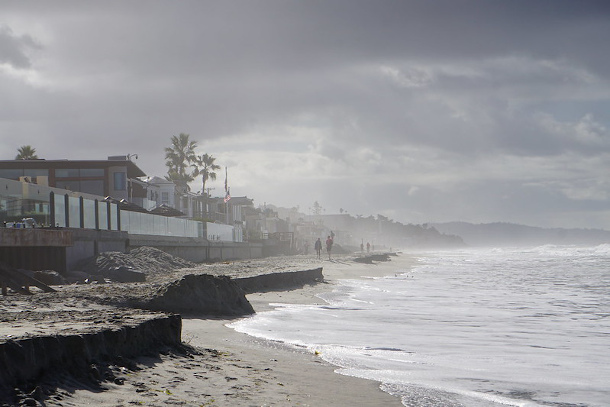
Sea level rise is threatening homes, businesses and infrastructure along California’s coast. (Photo: Emmett Institute, Flickr CC BY-NC 2.0)
Back in 2017 some California counties and cities took 30 oil companies to court to seek compensation for loss and damage related to climate disruption. The suits claimed the companies, including Exxon, BP, Chevron and Shell knew the widespread use of their products would upset the climate balance and deliberately put Californians at risk of sea level rise and wildfires, and lied to the public about it. Billions of dollars are at stake in these cases. The oil companies wanted the cases tried in federal court, but now the U.S. Circuit Court of Appeals for the Ninth District has sent the litigation to California state courts, where if the cases are proven, state law allows juries to make major awards for damage. But wait. There are similar cases in other jurisdictions so before it is all over the US Supreme Court may get involved. Here to explain is Vermont Law School Professor Pat Parenteau. Pat, welcome back to Living on Earth!
PARENTEAU: Thanks, Steve. Very good to be with you.
CURWOOD: And just to be clear, on the record, you've given some pro bono advice to some of these plaintiffs here.
PARENTEAU: That's correct. Pro bono, for free.
CURWOOD: What exactly is the argument that the California cities and counties are making? Why do they say that these fossil fuel companies should be on the hook for paying for some of the costs of dealing with climate impacts?
PARENTEAU: Right, and the impacts they're talking about are real. They're focused on the coastal zone of California. They're focused on sea level rise, storm surge, flooding, coastal erosion. They have the science behind them to say that what's happening to California's coast is the result of climate change and carbon pollution of the atmosphere. And they're saying that these defendants are the major contributors to the atmospheric pollution that's causing this damage, and the counties and cities are having to expend significant amounts of money to try to armor plate the coastline against these changes, or to move facilities out of the danger zones, the high hazard zones, all of which costs lots of money, causes lots of disruption. And they're saying all of this lies at the feet of the oil industry, because they knew this was coming. They knew it was going to be significant. They didn't warn anybody about it. They tried to cover it up; many times, they were successful in covering it up. Had they not done that, steps could have been taken long ago to either address the emissions that are causing this problem, or at least get started on adaptation planning. That's the nature of the damages they're seeking; they're actual costs, they're not hypothetical numbers. And also the conduct of the defendants, which is now almost a matter of public record. There's been so many of the documents now have come to light that prove what the companies knew and how they dealt with the knowledge. So it's a really classic tort case, where it's the conduct of the defendants that's the real issue as much as anything.
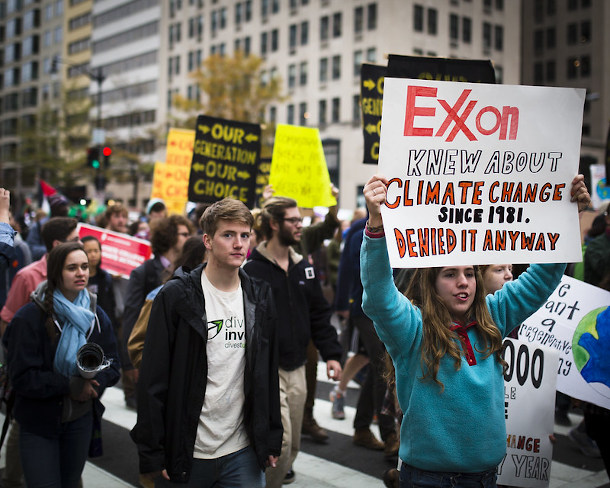
A protester carries a sign calling out fossil fuel giant Exxon for quietly studying climate change decades ago, while downplaying the risks publicly. (Photo: Johnny Silvercloud, Flickr CC BY-SA 2.0)
CURWOOD: In other words, the oil companies knew about the problems of greenhouse gases, and yet did not take action and in fact, misled the public? How important is that to the case?
PARENTEAU: I think that's very important. It is an act of misleading and lying, not to put too fine a point on it, about what you did know, and what you did about it. And there's a very strong line of cases in California, some of the precedents deal with lead paint, for example. California sued the paint manufacturer Sherwin-Williams and others and said, you actually knew that lead paint was going to create hazards as the paint weathered, and as it came off the walls inside of homes or on the outside of homes, and as children began playing in these areas, and ingesting this lead, and doing serious damage to their brains. This was all information you had, decades ago, and you, you hid it from the public. And you told mothers to paint their nurseries because lead was durable, and it was easy to clean. Instead of saying, you know what, at some point this lead is going to get out of the paint and onto the floor and expose your kids to it, and that's going to be dangerous. They didn't do that. So California won a huge damage award against the paint manufacturers, over a billion dollars to go in and de-lead these various residences that have a high level of, of leaded paint in them. So that's a key precedent, actually, for these climate cases, because it's the same kind of behavior of companies selling a product, knowing it's dangerous, and not disclosing that.
CURWOOD: Pat. Let's say that, for whatever reason, you decided to represent the oil companies. What would you be most worried about in these cases, if you were representing them?

The runways of San Francisco Airport are just 10 feet above current sea level. (Photo: Nathan Rupert, Flickr CC BY-NC-ND 2.0)
PARENTEAU: The first thing I'm going to be worried about is the discovery process in these cases, which is open now, the plaintiffs can proceed to call some of these corporate executives and put them under oath in a deposition and start asking them very specific questions and showing them documents and saying, "As far back as the 1960s, even, you began studying these problems, and you knew, right?" And so you're going to ask these people questions about what they knew, when they knew it, what they did with it, why they didn't disclose it. Did they fund active anti-legislative movements to prevent Congress from adopting, for example, the Waxman-Markey law, which would have created a cap and trade program for dealing with carbon emissions decades ago? And they're gonna have to answer those questions, the same way that tobacco executives ultimately had to answer questions or face even more serious repercussions from perjury. So that's one thing that the industry is very afraid of, is actually having on the record to admit what they've done. The other thing is, the reason the states want to be in state court, is because they rightly think they're going to have a more sympathetic jury pool to draw from. State court juries are different than the way federal juries are composed. It does give the states an upper hand. And of course, in the end, it's what the jury decides that matters. So that's what the industry is worried about: case gets to a jury after this lengthy discovery, in which all of their, chicanery, if you will, has been revealed, and they're looking at some huge verdicts.
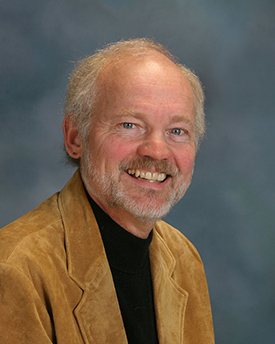
Former EPA Regional Counsel Pat Parenteau teaches environmental law at Vermont Law School (Photo: Courtesy of Vermont Law School)
CURWOOD: Hmm. So if these counties and towns should prevail, how much money do you think that the fossil fuel companies could be on the hook for?
PARENTEAU: Well, it's billions, that's for sure. You have to start thinking about the damage that's already been done to the California coast, and what's coming. For example, San Francisco is seriously contemplating having to move the airport. Anybody who's flown into San Francisco knows where that airport is. And if you look at the models of sea level rise that are affecting the California coast, that's a very, very difficult location to maintain an airport. I mean, the kind of sea walls that you would have to build to protect it are, you know, phenomenally expensive. So that's the kind of thing where the amount of damages are going to be very hard to quantify and estimate. And it may be that some of these cases don't result in a one-time damage award, they may be ongoing. And obviously, the extent to which we get a handle on some of these emissions and begin to really bring them down to the point where some of these worst case impacts aren't realized, that's going to be all the more important. That's another role for these court decisions, obviously, is to push the politics of climate hard, and to push the industry hard. And it's also going to be reflected in the financial markets, which are becoming more and more nervous about investments in all of this fossil fuel infrastructure, and extraction of all these sources of oil and gas all over the world. And we're seeing, you know, brokers like BlackRock pulling away from fossil investment, JP Morgan, issuing warnings to some of their companies that they loan money to, that's one of the biggest financiers of fossil fuel development in the world. You're really seeing movements in everywhere except the United States Congress, frankly, on this issue. And these cases are propelling that.
CURWOOD: Pat Parenteau is a Professor of environmental law at the Vermont Law School. Pat, thanks so much for taking the time with us again.
PARENTEAU: My pleasure, Steve, thank you.
Related links:
- InsideClimate News | “In Setback to Industry, the Ninth Circuit Sends California Climate Liability Cases Back to State Courts”
- Read the 9th Circuit opinion in the San Mateo et al. case
- The 9th Circuit opinion in the City of Oakland et al. case
[MUSIC: Sally Nyolo (Cameroun) & Shingo2 (Japan), “Tilma” (remix) on Drop the Debt (annulons la dette), by Sally Nyolo/Sally Nyolo-Sylvin Marc, World Village/Harmonia Mundi]
Lyme Disease Risk is High in City Parks, Too
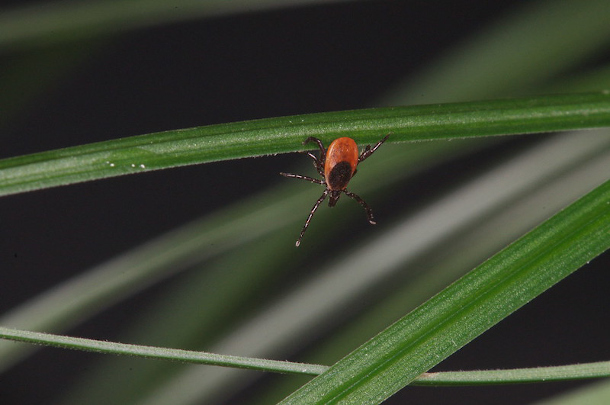
A female blacklegged tick reaches out her forelegs in search of a blood meal. (Photo: James L. Occi / Armed Forces Pest Management Board, Flickr CC BY-NC-ND 2.0)
CURWOOD: You might be thinking it’s perfectly safe to head out to a park to get some fresh air during the pandemic but be careful. Lurking in the leaf litter and elsewhere in the park might be the tiny ticks that carry Lyme disease. Kara Holsopple from The Allegheny Front has the story.
HOLSOPPLE: Thomas Simmons and his biology students from Indiana University of Pennsylvania, collected black legged tick samples from random sites in four of the large Pittsburgh parks in 2015 and 2016, including Schenely Park
SIMMONS: This is Prospect Hill, a hotspot.
HOLSOPPLE: The trail is shaded by trees on either side and Simmons drags a one meter square of white heavy flannel material along the edge of the path.
SIMMONS: I'm going to veer off a little bit into the woods, get off of the pavement and the gravel here.
HOLSOPPLE: The idea is that the ticks stick to the flannel which is about the size of a beach towel as it's pulled along the ground. In a few weeks it will be the peak of nymphs season that's the stage between the larval tick and an adult. And a bite from a nymph is how most cases of Lyme disease are contracted someone sets.
SIMMONS: They're attracted to vibrations, heat, shadows. I mean they are well equipped to find the host. It’s like a heat seeking erected really.
HOLSOPPLE: After about 10 steps, he carefully checks the fabric.
SIMMONS: Oh, there's one right there. Oh, my goodness. So take a look that's small.
HOLSOPPLE: It's the size of a poppy seed. Simmons and his team also set up stations within the woods where nymphs prefer the cooler moist habitat. The study about infected ticks in the parks was published online in the Journal of Medical Entomology last September.
So what did you find?
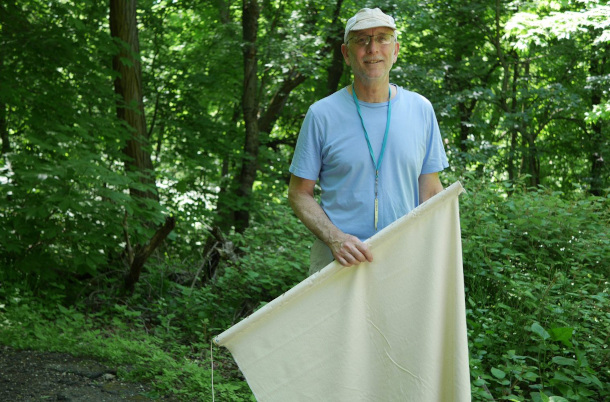
Thomas Simmons and his team used flannel “drags” to sweep over vegetation at the edge of trails and wooded areas to find and collect blacklegged ticks for the study. (Photo: Kara Holsopple / The Allegheny Front)
SIMMONS: So overall, for all the parks 50% of the adult ticks were infected. And 20% of the nymphs, we call that infection prevalence and those infection prevalence’s are characteristic of a region which is highly endemic for Lyme disease, which Western Pennsylvania now is and those present infection rates are comparable to what has historically and presently is found in Southeastern New York where we typically use that as kind of I don't say worst case scenario, but but as a good comparison to determine how bad I can use the word bad. But how much concern there is or how high the Lyme disease risk is probably a better way to put it.
HOLSOPPLE: Though the risk is high?
SIMMONS: So the risk is high. Also, not only is it important in terms of what percent of the ticks are infected, but it's important to know what the density the abundance of the density of the ticks are. Because what really determines Lyme disease risk is the the numbers of infected ticks, and the density of infected nymphs and the density of infected adults in these parks is also comparable to the East Coast. I should also note that not every infected tick infects. So that's important to realize that these are really high rates 50% of adults are infected, you might think, Oh my goodness. 50% if I'm bitten by a tick, adult tick, I have 50 % chance of being affected or if I'm bitten by a nymph, I have 20% chance of being affected. No, not every infected tick.
HOLSOPPLE: Simmons estimates the tick density in Pittsburgh parks is about one tick per two square yards. He says the study findings certainly don't mean people shouldn't use the parks, but just take precautions. his advice to avoid being bitten by a tick is to stay to the center of trails. Wear light colored clothing so you can see the ticks clinging to your clothes and tuck long pants into socks. You can also treat your clothing with a chemical insecticide or essential oils. When you go home, toss your clothes into a hot dryer for 10 minutes.
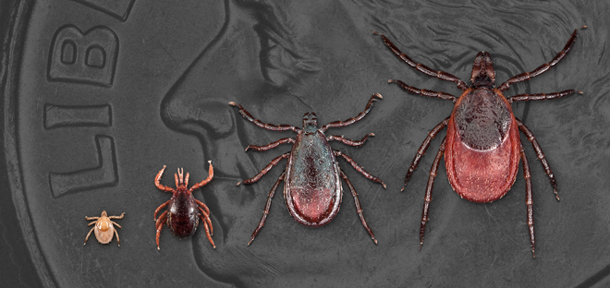
From left, the larvae, nymph, adult male and adult female forms of the blacklegged or deer tick, which can carry Lyme disease. (Photo: CDC)
SIMMONS: That day, that night, definitely take a shower and check every part of your body and then some.
HOLSOPPLE: Simon says a nympho feel like a little bump or pimple. So what is the significance of what you found for Pittsburgh and also for urban areas where they have you know, Parks like this.
SIMMONS: So I think the take home message is that when you use a park By all means, do this is a good thing during this pandemic, especially, you know, you got to get out and getting exercise anytime a year is really important. And it's just, it's healthy. It's it's, it's just good for you. However, like anything else, there's risks, there's risks of crossing a street, there's risks of riding a bicycle. So not only is it useful, important for any Pittsburghers to know that there is Lyme disease risk, and they should take precautions as they should in rural suburban parks and in their backyards. But it's sort of a wake up call and and emphasizes the importance of looking at tick borne disease risk of Lyme disease risk in city parks in any place in the country.
HOLSOPPLE: What can be done by parks or people who manage these types of spaces to manage ticks? Is there anything that you can do to minimize tick exposure for for people who are using the parks?
SIMMONS: Basically, ticks and Lyme disease and other tick borne diseases? They're here to stay? We do not have a vaccine yet. So it's all about prevention. But also parks can take preventative measures, and that's basically education, Lyme disease awareness signs. Just like now with COVID-19, what do you see? Social distancing signs. We should be doing the same thing for tic signs in areas that I think well, I think every entrance should be posted, but at the minimum areas that have a high numbers like here. Also, and I think it's at least my experience going through all these parks is that the trails that most people use are well managed. Right, the trail we are on doesn't have vegetation and grass growing out into it. Right, we're we're walking on part dirt gravel as you saw, you could still pick up nymphs there, but we'd pick up a lot more if I was dragging through the leaf litter believe me. As long should be kept short, trails should be kept clear and the edges should be manicured.
HOLSOPPLE: Thomas Simmons is a biology professor at Indiana University of Pennsylvania. For Living on Earth I'm Kara Holsopple.
CURWOOD: Kara Holsopple’s story comes to us courtesy of The Allegheny Front.
Related links:
- The story on The Allegheny Front | “Lyme Disease Risk Is High in City Parks, Too”
- CDC | Learn more about ticks and tickborne diseases
- Lyme disease and climate change
- Listen to our story on the idea of using guinea fowl for backyard tick control
[MUSIC: Jorma Kaukonen, “Izze’s Lullaby” on River of Time, by Jorma Kaukonen, Red House Records]
CURWOOD: Living on Earth is produced by the World Media Foundation. Our crew includes Naomi Arenberg, Bobby Bascomb, Paloma Beltran, Thurston Briscoe, Jenni Doering, Jay Feinstein, Don Lyman, Isaac Merson, Aynsley O’Neill, Jake Rego, Kori Suzuki, and Jolanda Omari. Tom Tiger engineered our show. Alison Lirish Dean composed our themes. You can hear us anytime at L-O-E dot org, Apple Podcasts, and Google Podcasts, and like us, please, on our Facebook page- Living on Earth. We tweet from @livingonearth. And find us on Instagram at livingonearthradio. I’m Steve Curwood. Thanks for listening!
ANNOUNCER: Funding for Living on Earth comes from you, our listeners, and from the University of Massachusetts, Boston, in association with its School for the Environment, developing the next generation of environmental leaders. And from the Grantham Foundation for the protection of the environment, supporting strategic communications and collaboration in solving the world’s most pressing environmental problems. Support also comes from the Energy Foundation, serving the public interest by helping to build a strong, clean, energy economy.
ANNOUNCER 2: PRX.
Living on Earth wants to hear from you!
Living on Earth
62 Calef Highway, Suite 212
Lee, NH 03861
Telephone: 617-287-4121
E-mail: comments@loe.org
Newsletter [Click here]
Donate to Living on Earth!
Living on Earth is an independent media program and relies entirely on contributions from listeners and institutions supporting public service. Please donate now to preserve an independent environmental voice.
NewsletterLiving on Earth offers a weekly delivery of the show's rundown to your mailbox. Sign up for our newsletter today!
 Sailors For The Sea: Be the change you want to sea.
Sailors For The Sea: Be the change you want to sea.
 The Grantham Foundation for the Protection of the Environment: Committed to protecting and improving the health of the global environment.
The Grantham Foundation for the Protection of the Environment: Committed to protecting and improving the health of the global environment.
 Contribute to Living on Earth and receive, as our gift to you, an archival print of one of Mark Seth Lender's extraordinary wildlife photographs. Follow the link to see Mark's current collection of photographs.
Contribute to Living on Earth and receive, as our gift to you, an archival print of one of Mark Seth Lender's extraordinary wildlife photographs. Follow the link to see Mark's current collection of photographs.
 Buy a signed copy of Mark Seth Lender's book Smeagull the Seagull & support Living on Earth
Buy a signed copy of Mark Seth Lender's book Smeagull the Seagull & support Living on Earth

